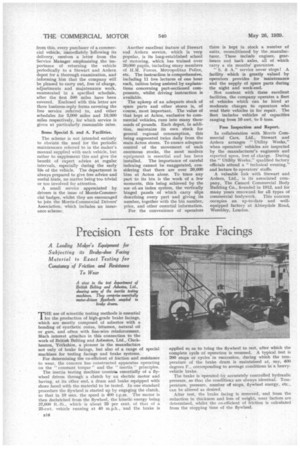Precision Tests for Brake Facings
Page 50

If you've noticed an error in this article please click here to report it so we can fix it.
A Leading Maker's Equipment for Subjecting its Brake-shoe Facing Material to Exact Testing for Constancy of Friction and Resistance To Wear THE use of scientific testing methods is essential for the production of high-grade brake facings, which are mostly composed of asbestos with a bonding of synthetic resins, bitumen, natural oil or gum, and often with fine-wire reinforcement. Much interest attaches in this connection to the work of British Belting and Asbestos, Ltd., Cleckheaton, Yorkshire, a pioneer in the manufacture not only of brake facings, but also of a range of special machines for testing facings and brake systems.
For determining the co-efficient of friction and resistance to wear, the concern has constructed apparatus operating on the "constant torque" and the " inertia " principles.
The inertia testing machine consists essentially of a flywheel driven through a clutch by an electric motor and having, at its other end, a drum and brake equipped with shoes faced with the material to be tested. In one standard procedure the flywheel is started up by engaging the clutch, so that in 10 secs, the speed is 400 r.p.m. The motor is then declutched from the flywheel, the kinetic energy being 37,000 ft.-lb., which is about 25 per cent. of that of a 25-cwt, vehicle running at 40 m.p.h., and the brake is
applied so as to bring the flywheel to rest, after which the complete cycle of operation is resumed. A typical test is 200 stops or cycles in succession, during which the temperature of the brake drum is maintained at, say, 400 degrees F., corresponding to average conditions in a heavyvehicle brake.
The brake is operated by accurately controlled hydraulic pressure, so that the conditions are always identical. Temperature, pressure, number of stops, flywheel energy, etc., can be altered as desired.
After test, the brake facing is removed, and from the reduction in thickness and loss of weight, wear factors are determined, whilst the co-efficient of friction is calculated from the stopping time of the flywheel.




















































































